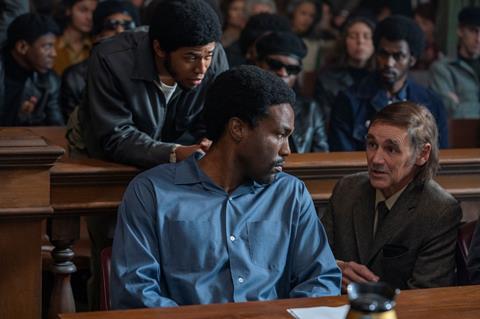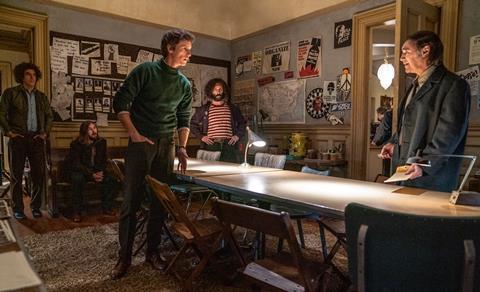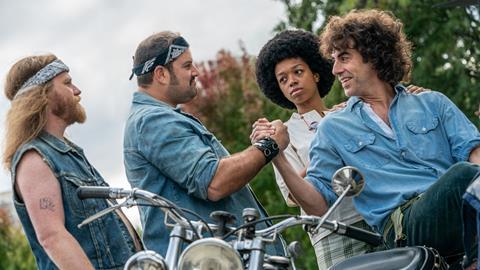Phedon Papamichael ASC unlocks the visual puzzle of Aaron Sorkin’s politically charged legal drama.

It’s 1968 and the United States is in turmoil. Martin Luther King Jr. is gunned down by an assassin in Memphis, Robert F. Kennedy is shot and killed in LA. The Vietnam War is at its height, with over 30,000 American casualties and 1,000 more US troops killed each month. In August, scores of antiwar protestors gather outside the Democratic National Convention in Chicago and are tear-gassed and beaten by police and the National Guard.
The following year, eight antiwar activists are put on trial for conspiring to incite a riot facing charges brought by a new Republican administration aiming to stifle and silence the movement.
Sounds familiar? “The script didn’t change to mirror the times, the times changed to mirror the script,” says Aaron Sorkin in the production notes for The Trial of the Chicago 7 which he originally wrote in 2007, intending it for Steven Spielberg. “Just as Fred Hampton (leader of the Black Panthers in 1968) was killed by the police in the middle of the trial, George Floyd, Rayshard Brooks, Breonna Taylor, and countless others are similarly tragically killed [today]. Suddenly protestors are met with tear gas, riot clubs.”
Sorkin has said that until Spielberg brought his attention to it he was unaware of the Chicago 7, but the volatile cocktail of injustice, protest and repression couldn’t be more timely. Netflix has intentionally brought forward release ahead of the US election.
The West Wing creator has lassoed a heavyweight cast including a trio of Brits in Eddie Redmayne, Sasha Baron Cohen and Mark Rylance with Jeremy Strong, Watchmen star Yahya Abdul-Mateen II plus Michael Keaton.
‘The script didn’t change to mirror the times, the times changed to mirror the script,’ Aaron Sorkin
Phedon Papamichael ASC, Academy Award-nominated for Alexander Payne’s Nebraska, is the film’s cinematographer. He says the biggest challenge was working with a script that was intricately structured and dense in dialogue but visually imprecise.

“Aaron’s writing is very nonlinear,” Papamichael tells IBC365. “Not just jumping forward or back in time but constantly criss-crossing these timelines. We’d sometimes just record one line and then move to another line that won’t necessarily be one that progressively follows from it.”
The actual trial took place over six months (starting September 1969) and involved 200 witnesses. In telling what is essentially a legal drama, the trick was to find ways of making the story cinematic.
“We’re creating this visual puzzle and filming little impressions and vignettes to support certain lines and moments and beats of the trial in order to help break it up visually so you don’t feel like you’re stuck in a courtroom.”
Sorkin had structured the courtroom scenes and the flashbacks very specifically, with most of the intercuts written in. Nonetheless, tracking this on the page proved tricky when it came to the logistics of filming. It fell to Papamichael to create and organise the coverage – the reaction shots and atmospheres which are needed editorially to tell the story.
“With Aaron it’s all about the word and the structure of this overlapping puzzle that he sees in his head,” says Papamichael. “He is not a visual director like James Mangold or David Fincher. He relies heavily on the cinematographer and designer to take care of all that.”
He continues, “If he saw the actor speaking the line on camera he was good with that take. But I know we need reactions of the jury and of the prosecutor to build the scene. He doesn’t even look at the screen of the monitor on set. He literally closes his eyes and just listens to it. For Aaron, it’s all about the rhythm. He knows exactly what he wants, you show him that and often he’ll think he doesn’t need anything else – which is may be true most of the time – but you have to find a way to shoot so it’s not just two hours of talking heads in a courtroom.”
Since the script didn’t spell out the chronology of the trial, Papamichael worked with the script supervisor to strip the flashbacks and jumps forward into a calendar in order to schedule the shoot.
“Since the trial takes place over such a long period I wanted to convey that passage of time. So on the opening day of the trial I play it sunny, and as we go through the winter months I play it moodier. I had to assign different moods and assign specific grammar for specific witnesses. So certain scenes would be better if it were raining, others if it were overcast.”
‘We’re creating this visual puzzle and filming little impressions and vignettes to support certain lines and moments and beats of the trial,’ Phedon Papamichael
Lacking the budget for a huge crowd of extras on call (the film cost $35 million, which is moderate for a film of this scale) Papamichael first shot the courtroom scenes from one direction and then reshot them from a different angle when they had the extras to fill the room.
The courtroom scenes are more composed and static in contrast to scenes set outside the court which are shot handheld and are energised by documentary footage of the riots.

“Recreating the protests at the actual locations in Chicago enables us to create a structure that gets the movie away from being a traditional courtroom drama,” Papamichael explains. “Since we are also limited in terms of extras in the crowd [there were around 10,000 people on the streets of Chicago in 1968 and the film had 175 on set] the best way to handle that was to merge our cameras into the scene like an actual documentary crew and not create big objective wide shots.”
Papamichael filmed with the same camera and lens package he used to acclaim on sixties-set drama Ford v Ferrari (aka Le Mans 66). This was an ARRI Alexa LF and Mini LF combined with Panavision anamorphics specially configured to fit the large format sensor.
“Because all the characters have their own agendas, I wanted to be able to connect them and get everyone’s reaction. The large format really lent itself in the 2.40:1 aspect ratio to covering these multiple characters [defendants and lawyers] sitting in a row in the court room.”
The film is intercut by editor Alan Baumgarten, ACE (editor of Sorkin-directed Molly’s Game), with archive of the events culled from televised coverage, amateur Super 8 and police film of the riots.
Some of the footage was taken from Haskell Wexler’s Medium Cool, a cinema verité-style drama that takes place in Chicago in the summer of 1968 and combines fictional and non-fictional content. The film served as one of Papamichael’s inspirations during the shoot
- Read more: Behind the scenes: Project Power
“The footage that we generated in our recreation of the riots is more kinetic and documentary-like, but we’re not intentionally making our characters part of a documentary,” Papamichael says. “This is still a movie.
“In the film, we show a 4-second vignette, then you are back in the courtroom and a guy says two lines, then you move to documentary found footage and then you go to another timeline. The pacing of Aaron’s storytelling really lends itself to be able to throw all these pieces together. It’s not like we have a 20-minute sequence of the riots.”
The large ensemble cast assembled for Chicago 7 proved a handful. Papamichael contrasts the experience to working with director James Mangold.
“We don’t like to preconceive too much… we look at what is happening in the moment. So, with Joaquin Phoenix on Walk The Line we never really knew what we were going to do – the inspiration comes from the performance.
“Every director is different,” he adds. “In Chicago 7, I ended up in charge of blocking the movie and assigning who gets what shots because Aaron didn’t really want to talk to them about that. So, it’s like ‘don’t I get a close up?’ and ‘isn’t this scene about me?’ – and I was very much caught in the middle. Which is fun… I love working with actors, but there’s lots of strong individual personalities on this one.”
He elaborates; “Some actors preferred to improvise. Mark Rylance is a theatre director and actor with a very different approach – he’s very focussed. Jeremy is a super-method actor and Sasha is just goofing around between takes. So, bringing that crazy group together was hard. Having to capture it all and make it work for Aaron and for the actors not be super frustrated… that was the particular challenge on this movie.”
The Netflix effect
The film began life at Paramount intended for theatrical release. When Covid struck and cinemas closed, the studio off-loaded it to Netflix which ramped forward its release.
“I haven’t shot for TV in 30 years and under different circumstances I’d be disappointed this was on Netflix. I shoot for the big screen and I want people to experience it in theatres,” says Papamichael. “But probably more people will view it this way on Netflix.
“There was definitely a great urgency to get it out before the election. It’s an advantage to our film in one way that everything that’s going on [in the US] makes it relevant, but it’s also so tragic.”

























No comments yet